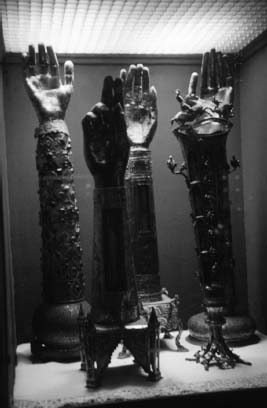ChristianitySigns and Symbols |
Have relics ever been important for Christians? |
Since very early times, Christians have cultivated a sense of the sanctity of the remains and memorabilia of holy persons. Since Christians believed early on that Jesus had resurrected bodily from his tomb, they began to focus (by around the third or fourth century) on other reminders of Jesus’ earthly life. People sought, and sometimes believed they had found, the cross on which Jesus was crucified, the nails that fastened him to it, or the crown of thorns he had worn. According to ancient tradition, St. Helena, mother of the Emperor Constantine, discovered the “true” cross of Christ during excavations for her son’s new basilica of the Holy Sepulcher in Jerusalem. The resulting devotional ritual of venerating the sacred relics there may have been among the first of its kind and the beginning of a much-expanded practice.
During late medieval times the Holy Shroud, thought to be the winding-cloth in which Christ had been buried, became a center of widespread devotion in Europe. A veil, said to be the one with which St. Veronica wiped Jesus’ face during his march to Calvary, where he was crucified and to which an image of Jesus’ face was transferred, was venerated at St. Peter’s in Rome from the thirteenth century on. Far more numerous, of course, are the relics of martyrs and saints, some dating back to early Roman persecutions of Christians. Sacred remnants can be anything from entire bodies, skeletal remains, to intact or fragmentary bones and skulls, or items once owned or touched by the holy person. Claims to possession of certain sacred relics have often conflicted—there are several heads of John the Baptist, for example. Famous relics conferred a great deal more than religious prestige on the churches, monasteries, and shrines that owned them, for the more renowned and powerful the relic, the greater the traffic of pilgrims to the holy place. Relics generally have been more significant for Catholic and Orthodox Christians.

Medieval reliquaries in the shape of the body part they were designed to contain. These hold arm and hand bones of holy persons.
